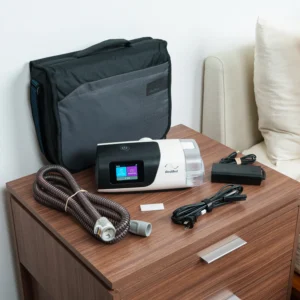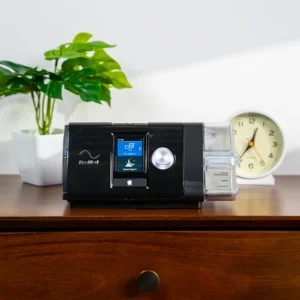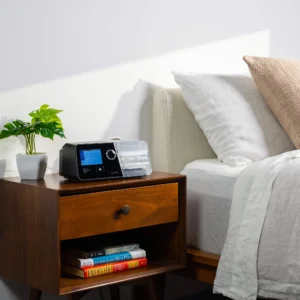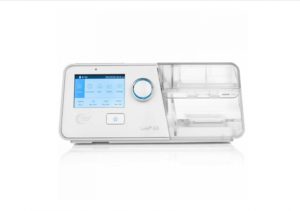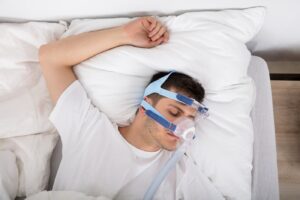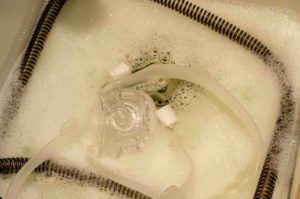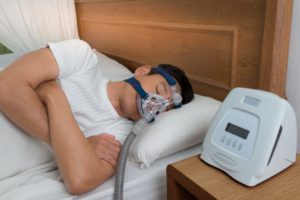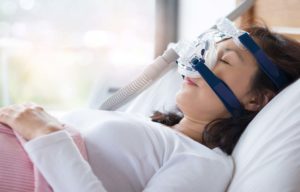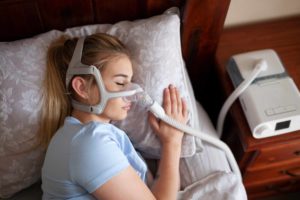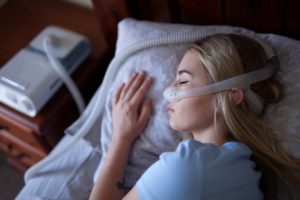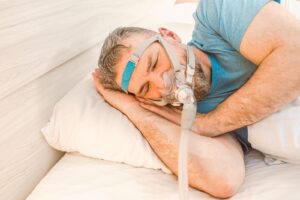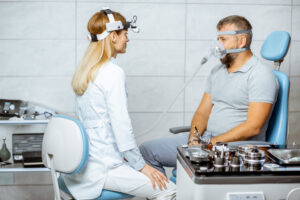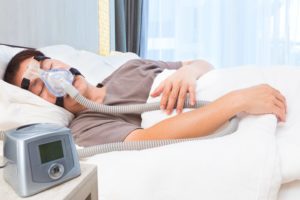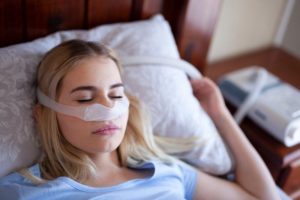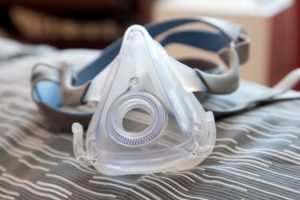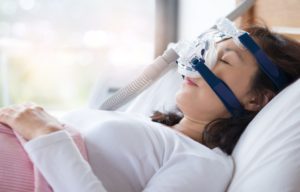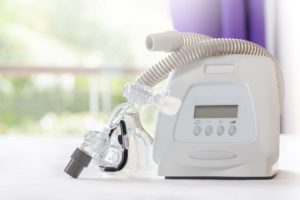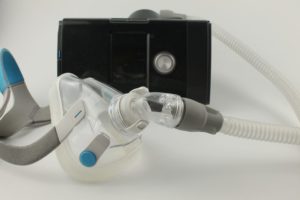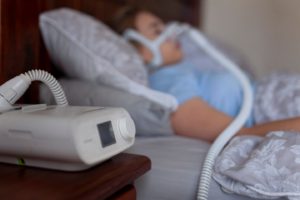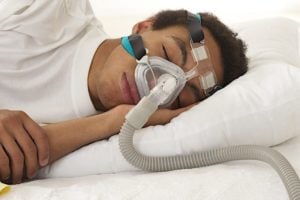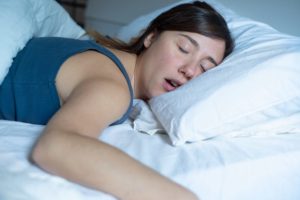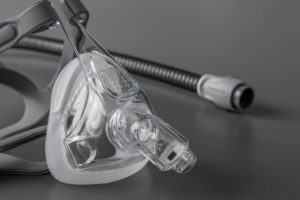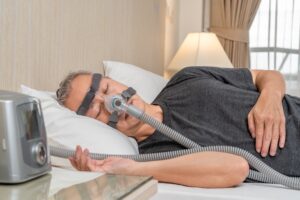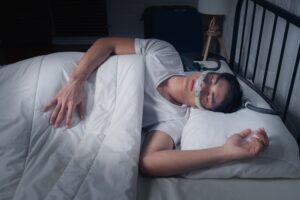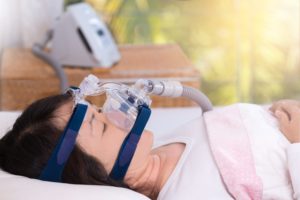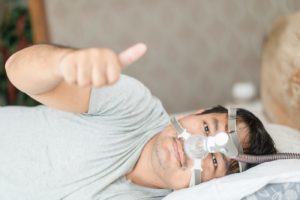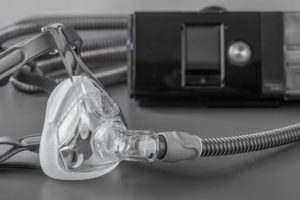When you buy through our links, we may earn a commission. Products or services may be offered by an affiliated entity. Learn more.
What Is an APAP Machine?
- APAP machines automatically adjust air pressure throughout the night to align with your breathing patterns, providing a more comfortable alternative to fixed-pressure CPAP therapy.
- APAP devices treat obstructive sleep apnea by maintaining an open airway and can help reduce daytime fatigue, snoring, and other sleep apnea symptoms.
- Common side effects, such as nasal dryness, mask discomfort, or mild bloating, can often be resolved with proper mask fit, humidification, and pressure adjustments.
- APAP devices require a prescription and typically cost between $500 and $1,500, with potential coverage through Medicare or private insurance.
For many people with sleep apnea, an auto-adjusting positive airway pressure (APAP) machine offers a more comfortable approach to treatment by adapting pressure levels as you breathe. This automatic adjustment helps ensure you receive the right amount of air pressure at any given moment: enough to keep your airway open, but not so much that it feels uncomfortable.
To better understand the APAP device, we’ll explain how it works, the benefits of using one, and how to avoid common issues. We’ll also explain how and where to purchase one.

Exploring CPAP Machines — But Haven’t Been Tested Yet?
Start with our easy, at-home sleep test. It’s stress-free and effective. Get results within a few days.
What Is an APAP Machine?
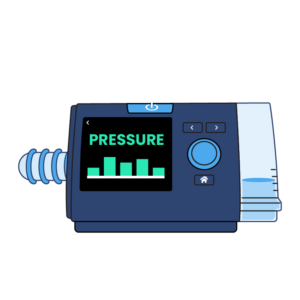

Also known as an auto-CPAP, an APAP machine is one of three main types of CPAP devices. Unlike a CPAP machine (the most common type), which uses a fixed air pressure that doesn’t fluctuate, an APAP machine automatically adjusts the positive airflow according to each person’s needs.
Because they adapt to the breathing patterns of each user, APAP machines are often an effective way to treat obstructive sleep apnea (OSA) symptoms with less disturbance.
What’s the Difference Between an APAP Machine and CPAP?
APAP machines are similar to continuous positive airway pressure (CPAP) machines. Both machines are designed to treat OSA, a condition where the throat muscles relax during sleep and block the airway.
The main difference between APAP and CPAP is that APAP automatically adjusts air pressure throughout the night based on your breathing patterns, while CPAP delivers one constant, fixed level of pressure. For this reason, APAP devices may be a preferable form of treatment for people with pressure intolerance.
What Does an APAP Machine Look Like?
An APAP machine typically looks similar to a standard CPAP device: a small, rectangular unit that sits on your nightstand and connects to a mask via a flexible hose. Most models feature a display screen, control buttons or a touchscreen, and a built-in or attachable humidifier. Modern APAP machines are compact and designed to operate quietly, with some models small enough for travel.
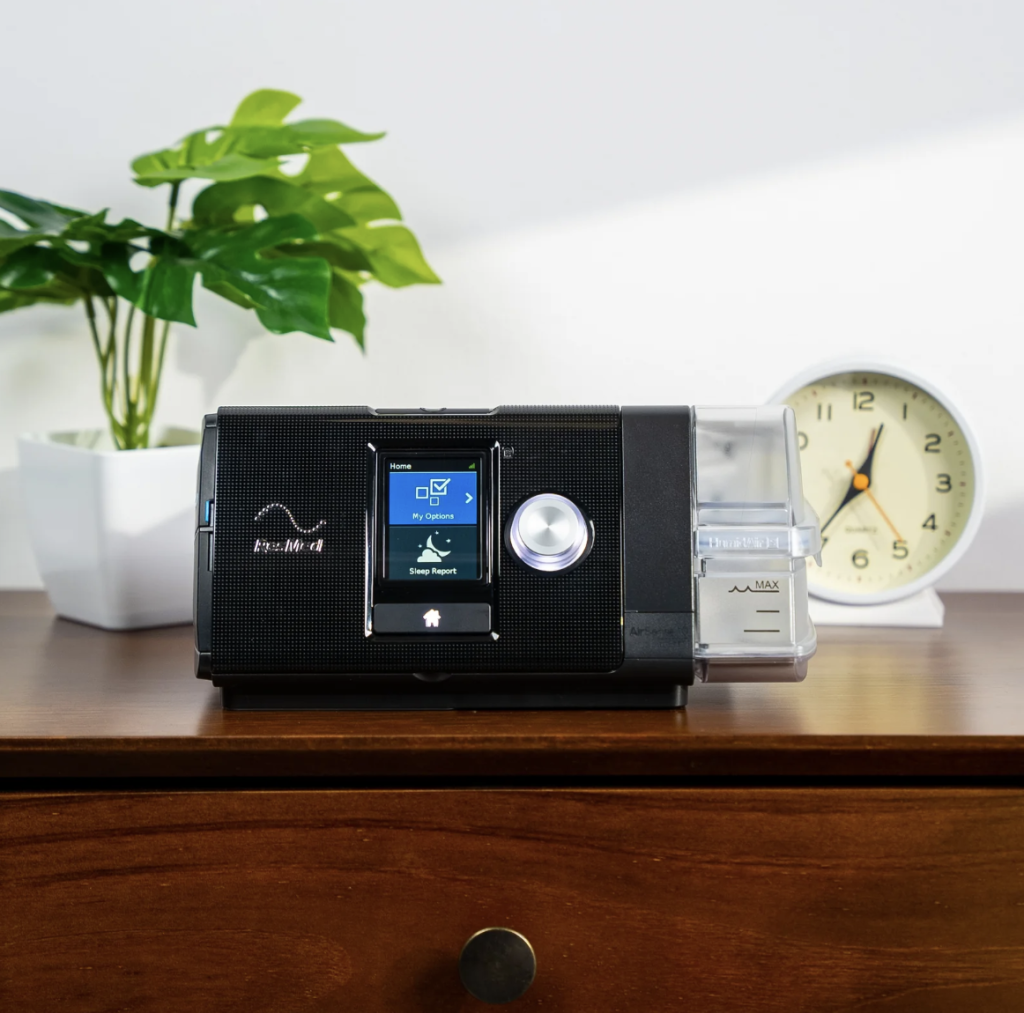
How Does an APAP Machine Work?
APAP machines take in outside air in your room through a filter, use a motor to push it through a hose, and deliver it to the sleeper via a mask. The mask may cover the sleeper’s nose, mouth, or both. Most users place the machine itself on a nightstand. With a set pressure range and complex algorithms, an APAP machine adapts to a person’s varying air pressure needs throughout the night.
Using advanced sensors, the APAP device detects airflow loss or reduction, then automatically increases the air pressure. Once the sleeper’s breathing normalizes, the APAP machine lowers the air pressure back to the minimum necessary level. Specific device algorithms vary between manufacturers .
What Is an APAP Machine Used For?
An APAP machine is used to treat sleep apnea, a condition characterized by shallow breathing or breathing that stops altogether during sleep.
OSA involves muscle relaxation in the throat that causes the airway to close, blocking inhalation. A variety of factors can contribute, including advancing age, higher body mass index (BMI), sex, head and neck anatomy, sleeping position, substance use, and underlying medical conditions.
Central sleep apnea (CSA) entails problems with how the brain communicates to the muscles responsible for breathing, which results in pauses . Age, sex, certain drugs , and ascending to high altitudes can elevate the risk of the condition. Generally, APAP isn’t recommended or used to treat CSA.
Is an APAP Machine Right for Me?
Choosing the right PAP device depends on your diagnosis, comfort level, and breathing patterns. An APAP machine may be a good fit if you have obstructive sleep apnea and need air pressure that automatically adjusts to your body’s changing needs during sleep.
Benefits of an APAP Machine
APAP machines are designed to work with a person’s individual breathing variations for restorative sleep. By using the lowest effective pressure, they limit the claustrophobic sensation that some CPAP users experience, especially with high-pressure settings. Because of their adaptability, APAP machines can also more easily accommodate changes in the user’s sleep position, health, and body weight.
The positive pressure needed to maintain a person’s ability to breathe changes with sleep positions and stages of the sleep cycle. For example, higher pressure is needed when someone is lying on your back or during REM sleep. Weight changes, illness, and other factors can cause additional pressure changes throughout the night and over time.
People who use an APAP machine may experience less daytime fatigue due to undisturbed sleep. Continued use of an APAP machine can result in less anxiety, as well as improved productivity and memory .
People with allergies or occasional colds may especially benefit from APAP machines since they adjust the pressure as needed. Many APAP machines also record critical data that a medical provider can use to monitor your condition.
Side Effects of an APAP Machine
Like other positive airway pressure therapies, APAP machines are generally safe but can cause mild side effects for some users. The most common issues include nasal congestion, dryness, or irritation, especially if you’re not using a humidifier.
Some people experience mask discomfort, air leaks, or skin irritation where the mask makes contact with the face. Others may notice bloating or gas from swallowing air, known as aerophagia. These side effects are often temporary and can usually be resolved by adjusting the mask fit, using heated humidification, or working with a sleep specialist to fine-tune pressure settings.
Other Types of PAP Therapy
APAP isn’t the only form of positive airway pressure (PAP) therapy used to treat sleep apnea and other breathing disorders. While all PAP machines deliver pressurized air to help keep your airway open during sleep, they differ in how that pressure is delivered and adjusted.
- Continuous positive airway pressure (CPAP): CPAP is the most common and widely prescribed type of PAP therapy. It delivers one constant level of air pressure throughout the night to prevent the airway from collapsing. CPAP is often recommended as the first treatment option for people with obstructive sleep apnea.
- Bilevel positive airway pressure (BiPAP or BPAP): BiPAP machines use two pressure settings—a higher one for inhaling and a lower one for exhaling. This makes breathing out easier and is especially helpful for people who need higher pressure levels or have conditions like chronic obstructive pulmonary disease (COPD) or certain heart problems.
- Adaptive servo-ventilation (ASV): ASV is a more advanced form of PAP therapy designed for people with central sleep apnea or complex sleep apnea. It monitors your breathing in real time and adjusts airflow from one breath to the next to maintain a steady breathing rhythm.
Each type of PAP therapy works a little differently, and your doctor can help determine which machine best fits your specific diagnosis, comfort preferences, and treatment goals.
How Do You Get an APAP Machine?
If you’re considering getting an APAP device, it’s important to know the potential cost and prerequisites. We will explore prescription requirements, insurance coverage, and where to shop for an APAP machine.
Do You Need a Prescription for an APAP Machine?
Because the FDA classifies it as a Class II medical device , you need a prescription to purchase an APAP machine. Discuss your symptoms and diagnosis with your doctor to ensure the most effective treatment. Retailers, including online vendors, require a copy of your prescription.
Does Health Insurance or Medicare Cover APAP Machines?
Medicare and many health insurance providers often cover CPAP machines and basic accessories. When getting an APAP machine for sleep apnea, however, some carriers may require that you first use a CPAP machine unless your doctor specifically cites why you need an APAP device. Insurance companies also typically require a completed sleep study in addition to a prescription.
When getting a machine from your insurance company, you must adhere to compliance requirements, which include proper usage and minimum hours of usage within a specified time frame.
How Much Does an APAP Machine Cost?
APAP machines range in price from around $500 to $1,500. Devices with more advanced features, such as a heated humidifier, are on the higher end. Your out-of-pocket expense depends on your insurance coverage. If you have a high deductible, it may be more practical to pay for the device yourself. In this case, compliance regulations do not apply.
These prices don’t include masks, tubing, or accessories, which are sold separately. However, some retailers offer bundle deals that include the base unit and needed accessories.
Where Can You Buy an APAP Machine?
You can find APAP machines at brick-and-mortar medical equipment stores, online retailers, local sleep clinics, and insurance providers. Insurance providers often rent out the device in a rent-to-own arrangement.
When buying from a local store, you can inspect the machine before purchase, but there may be a limited selection. Online retailers typically offer a wider variety, lower prices, and a return policy in case the device doesn’t work for you. For shoppers buying a machine out of pocket, online retailers offer convenience and affordability provided you have a copy of your prescription.
How Do You Use an APAP Machine?
Although APAP machines are more flexible, they still present certain challenges, especially for new users. Some people have trouble finding a comfortable mask that fits securely. Others struggle to get used to wearing a mask or experience a dry throat the next morning. Even though it’s designed to improve your sleep, it may initially be difficult to fall asleep while using the machine.
There are several ways to make your sleep experience more comfortable for those who have sleep apnea. Sleepers can ease their way into regularly using an APAP machine by keeping the following in mind.
- Ensure Proper Fit: An ill-fitting mask can result in skin irritation, sores, and leaking air. Adjust the straps and headgear for a secure fit. If your weight changes or you can’t find a comfortable fit, you may need a different size or style.
- Mask Compatibility: PAP masks come in a range of styles and sizes, including full face, nasal, and nasal pillow. Most masks are designed to work with any machine. You may need special connection equipment, but many masks come with any necessary adaptors. If you’re unsure what mask is right for you, your medical provider can share advice.
- Use a Humidifier: APAP users may experience a dry throat and mouth, a stuffy nose, chapped lips, and other symptoms of dryness. To combat this, some devices include an adjustable, heated humidifier. Controlling the humidity helps enhance comfort, which may make it easier to use your machine regularly.
- Get Used to Wearing a CPAP Mask: Before using the APAP machine at night, try wearing your mask for short stretches while awake. Practice putting on the mask and turning on the machine. After getting accustomed to the feel and sound, start using it during naps. When it comes time to use it at night, the transition should be much easier.

Still have questions? Ask our community!
Join our Sleep Care Community — a trusted hub of sleep health professionals, product specialists, and people just like you. Whether you need expert sleep advice for your insomnia or you’re searching for the perfect mattress, we’ve got you covered. Get personalized guidance from the experts who know sleep best.
References
10 Sources
-
Perin, C., & Genta, P. R. (2021). Less may be more: CPAP vs. APAP in the treatment of obstructive sleep apnea. Jornal Brasileiro de Pneumologia, 47(6), Article e20210455.
https://pubmed.ncbi.nlm.nih.gov/34932732/ -
Slowik, J. M., & Collen, J. F. (2022). Obstructive sleep apnea. In StatPearls. StatPearls Publishing.
https://pubmed.ncbi.nlm.nih.gov/29083619/ -
Ghadiri, M., & Grunstein, R. R. (2020). Clinical side effects of continuous positive airway pressure in patients with obstructive sleep apnoea. Respirology (Carlton, Vic.), 25(6), 593–602.
https://pubmed.ncbi.nlm.nih.gov/32212210/ -
Isetta, V., Navajas, D., Montserrat, J. M., & Farré, R. (2015). Comparative assessment of several automatic CPAP devices’ responses: A bench test study. ERJ Open Research, 1(1), 00031–02015.
https://pubmed.ncbi.nlm.nih.gov/27730142/ -
MedlinePlus: National Library of Medicine (US). (2021, March 30). Sleep apnea.
https://medlineplus.gov/sleepapnea.html -
A.D.A.M. Medical Encyclopedia. (2021, July 12). Central sleep apnea. MedlinePlus.
https://medlineplus.gov/ency/article/003997.htm -
Badr, M. S. (2021, September 30). Central sleep apnea: Risk factors, clinical presentation, and diagnosis. In R. D. Chervin (Ed.). UpToDate.
https://www.uptodate.com/contents/central-sleep-apnea-risk-factors-clinical-presentation-and-diagnosis -
Burgess, K.R., Ainslie, P.N. (2016). Central Sleep Apnea at High Altitude. In: Roach, R., Hackett, P., Wagner, P. (eds) Hypoxia. Advances in Experimental Medicine and Biology, vol 903.
https://pubmed.ncbi.nlm.nih.gov/27343103/ -
A.D.A.M. Medical Encyclopedia. (2023, April 20). Positive airway pressure treatment. MedlinePlus.
https://medlineplus.gov/ency/article/001916.htm -
American Academy of Sleep Medicine. (2018, October 19). FDA reclassifies positive airway pressure as a Class II medical device.
https://aasm.org/fda-reclassifies-positive-aiway-pressure-class-ii-medical-device/


